At the end of a windy, rural road southwest of Whangārei, sits the little settlement of Waiotira. The school is tucked into the side of a sheltering hill looking back down the valley and over the railway track. Waiotira School is at the heart of this rural farming community. A special feature of the school is its position in the centre of Waiotira itself, enabling a continuing link between the school and the community. This is where news for the week is swapped and exchanged, and people meet up.
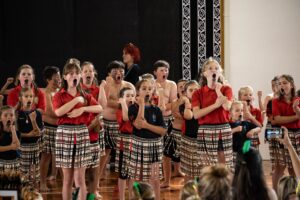
2022 Kapa Haka performance from Waiotira.
Many of the community’s social activities centre around the school with AG Day, Open Days, Whānau meetings, fundraising activities, sporting or cultural occasions being well supported by the community. Plans are underway to celebrate the school’s centenary next year, 2023 – a time to gather past and present whānau together to tell the early stories of origins, beginnings, hard work and change. It is also a time to plan and look forward into the future.
At the beginning of 2022, with a brand-new set of classrooms and a nearly new staff, (all of whom live in and are part of this community), they eagerly planned for the year ahead. The Enviroschools kaupapa was high on their list and is embedded in their policies and procedures. In this rural community, the whānau and ākonga want authentic learning framed by the environment around them.
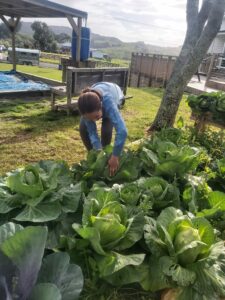
Checking out the growth of the cabbages.
The first task was to identify their Current Situation. The students identified what they knew about their school and their community. They brainstormed and unpacked the word ‘sustainability’ and explored the sustainable mahi they were already doing at their school such as growing vegetables, collecting food waste, composting and feeding vegetable scraps to the chickens, collecting the eggs to eat and sell to finance more chook food and other projects.
The tamariki also look after honeybees and sell and gift the honey to visitors and their community. The bee’s wax is used to make wax wraps for their lunches to help lessen the use of plastic. Kace, Leah, Ivy, Addy and Bella learnt how to use bee’s wax to make kawakawa balm from the leaves collected in the ngahere on Bella’s family farm. This also became part of their class economy and an authentic way to practise their maths.
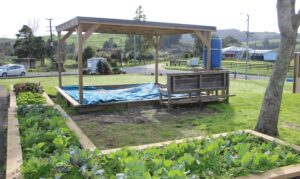
This māra huawhenua borders the sandpit area that is cleverly covered to provide both shade and rainwater collection.
As their old vegetable gardens had been demolished with the building of the new classrooms, a group of Tauraroa Area School students, (also an Enviroschool), came to help build a new raised garden bed where the Waiotira children then planted green vegetables over the wintertime. Several students sought out suitable recipes and cooked delicious dishes shared with the rest of the school.
Often things happened by chance as well as design. When hungry snails competed for the garden greens, the tamariki came up with a novel way to deal with the problem. They decided to hold “The Great Snail Race”! First, they had to hold “The Great Hunt” as they looked for the fastest snail. They created a racetrack and even trained them and painted the snail shells in their chosen racing stripe colours.
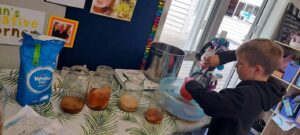
Splitting and feeding the kombucha.
The students were gifted a SCOBY, (Symbiotic Culture of Yeast Bacteria) to make kombucha with. Carter and Brady took responsibility for the care of the SCOBY and learned how to feed, care for and nurture their new “friend”. They found how to make the right solution of sugar, black tea, green tea and water to feed Toby and Joby (now there are two, one for the senior class and one for the junior class). Every fortnight, as the culture grew, they found they had new SCOBYs to give away or to start a new batch with.
Raising monarch butterflies and propagating house plants also became part of the school learning as the opportunities arose. Leah, one of the students, now has her own business raising and selling house plants.
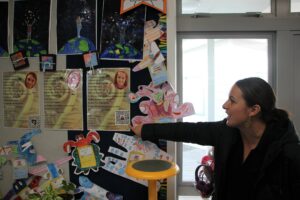
Principal Jess Southee points to the QR code that allows the listener to hear tamariki recite their pepeha.
The students have a sense of belonging to their school and community and put this into practice on Whanaungatanga Fridays. Embracing kotahitanga, they work together to keep their school clean and tidy. Reflecting their innovative spirit, a recent project saw some students develop an educational app based on the structure of popular casino apps, but instead of gambling, it rewards users with points for learning te Āo Māori concepts, such as pepeha, karakia, and waiata. The students take obvious P.R.I.D.E in their school values of participation, respect, innovation, diligence, and empathy, using every tool to reinforce these principles daily.
Looking back over all they had accomplished, it seemed like a good time to hold a Bronze Reflection and to celebrate what they had achieved. It was a great day for everyone as Susan and Jane, the Enviroschools Regional Coordinator and Facilitator, were welcomed into the school with a karanga and hakatau. The students beamed with pride as they shared what they had achieved and talked about their responsibilities and mahi around their school.
With the Waiotira School Centenary looming in 2023, it is a great time to discuss and plan for their next steps.
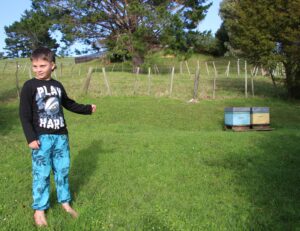
Kace keeps out of the bees’ flight line.
They asked questions:
- What else could we do to become a more sustainable school?
- How could we include our community even more?
- What do we do with our rubbish? What else could we do with it?
- We have bees – what could we do to feed them better?
- What could we do with the areas that are not being used?
- How could we be a more sustainable school in the future?
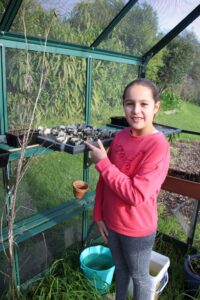
Showing the beetroot seedlings growing in the school WaiNursery
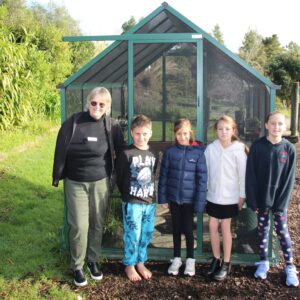
Northland Regional Council Enviroschools Facilitator, Jane Normal with Waiotira Enviro-group members outside the WaiNursery.
The tamariki have been full of wonderful ideas. They are planning on planting more fruit trees and starting a Pataka Kai so they can share their produce with others and help to make their community more food resilient. They are also planning to have a nature playground surrounded with native trees. This will transform a space in the school that is under-utilised and currently out of bounds. It is a great opportunity to draw the community together as they plan and search for materials, resources and people who can help. Together, they will take time to explore what others have done, asking for ideas and skills from the experts in their kura whānau and advice from other schools who have established nature play areas so that the school can be resourceful and make an area that can also be sustained.
The staff and tamariki of Waiotira School have made a wonderful start to their Enviroschools journey. It is exciting to see what will happen next as they explore and take action together with their community. Karawhiua!
